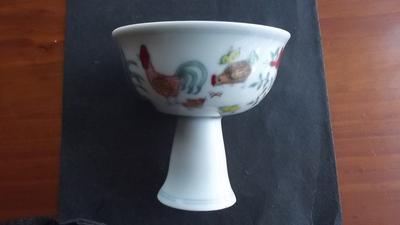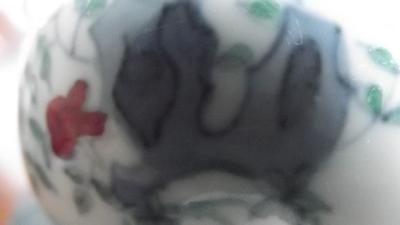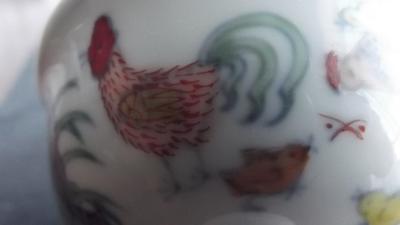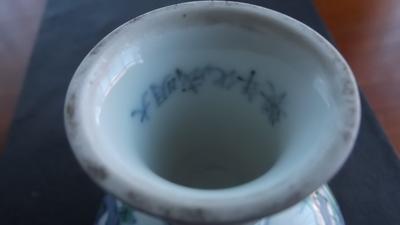INFO NEEDED PLEASE ON POSSIBLE AGE OF THIS STEMCUP
by Stewart
(Australia)




Hi Peter,
Would you be able to hazard a guess as to when this stem cup may have been made.
From what info I gathered on the internet it has features of the true Chenghua period doucai chicken cups.
Apparently the Chenghua chicken wine cups were thin, being about 2 mm.s thick as opposed to this piece which is about 3m.s thick, but this is a stem cup & I could not find any comparable stem cup on the net with this pattern & colour range, so I do not know whether the thickness is correct for early periods or thick, as for new reproductions,which I cannot seem to find anything remotely close enough to this piece for comparison.
However, all the glaze colours on this cup are correct, as those used in the Chenghua period, including having the raised thick, green glaze colour which can be felt on the surface, also the other colours are almost imperceptable to the touch as they should be.
Also, of interest, is that this cup has the look of having been painted with a native Chinese cobalt,a duller blue with evidence of greyish green colour,the manganese colour showing, where the blue has been heaped over....Tiamantis.com states that later Qing copies show the underglaze cobalt as a much deeper, brighter blue..being painted with imported blues,which only needed one even layer of application.
All this being said,the cup has a very glossy glaze,which could be indicative of later Ming copies or something more recent?.
Peter, do I have a quality modern piece made to almost the same standards of Chenghua doucai, using a native modern Chinese cobalt? if there is such a thing now?
and if so, how new could this cup be?
The porcelain on this cup is translucent,gives a resonant bell tone & has a slight greenish tinge, but not the ivory yellow, lower sheen, which was indicative of Chenghua period porcelain.
This cup apparently has the correct dimensions for height & width, but the inside hollow stem of this cup is different to any earlier Ming stems I have seen on the net.
This cup has a flat unglazed base, the rim ( about 2.75 mm.s thick)which is sharp on the exterior base edge, but has been slightly rounded smooth to the inside base edge & follows the lines up the flared contour of the foot stem.
The attachment of the stem to the cup has a rounded seamless join, narrowing to a flat & round 10 mm. diameter.
Hope this info gives you more to work with, than the red monochrome bowl, which happens also to be translucent in the biscuit areas...I think the porcelain is white but has a buff, iron speckled colour, from age, I think. The base may also have a clear glaze applied, but I cannot confirm this 100%.
The bowl also gives off a beautiful ringing tone when tapped...unfortunately, since there is no spectacular provenance to this bowl,even if it were genuine, major auction sites won't even bother to look at it, as past experience has shown me, I always get the same reply..item is "NOT SUITABLE"..it seems one cannot break the monopolistic status quo & there is no light shed to help collectors understand whether they in fact have a valuable piece.
Hope you can assist me with this one Peter, knowledge is precious,it promotes continued interest, appreciation & discernment...where would we be without a PERSON like YOU, to assist freely those with limited resources.
yours sincerely,
Stewart.








